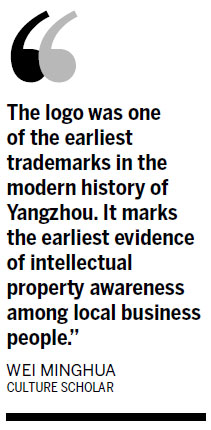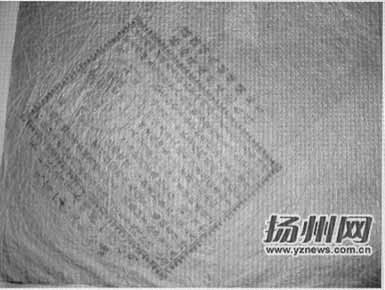A piece of century-old wrapping paper recently discovered in Yangzhou of Jiangsu province offers a revealing glimpse at early efforts to protect trademarks and brands.
Dating back to the early 20th century, the paper square was later identified as the wrapping paper used by a local producer of perfumed powder Xiefuchun.
A pattern comprising five bamboo tubes was printed in a place of distinction on the paper.
"The logo was one of the earliest trademarks in the modern history of Yangzhou," said a local culture scholar Wei Minghua.
"It marks the earliest evidence of intellectual property awareness among local business people," he told the local newspaper Yangzhou Evening News.
According to the story handed down by old folks, the founder of Xiefuchun was a specialist in both perfumed powder and traditional herbal medicines.
He combined his knowledge in the two fields and developed products with unique characteristics, making the store stand out among Yangzhou's cosmetics market at the time. At that time, the best-selling products in Xiefuchun are perfumed powder and hair oil.

Incapable of competing with Xiefuchun, some other small manufacturers in the city counterfeited its product.
The "five-bamboo" pattern was designed for its then-famous Wutong trademark, to differentiate the brand from counterfeited goods then, said Zheng Lianping, an executive of the Yangzhou Xiefuchun Cosmetics Co Ltd. The company's predecessor is the perfumed powder shop that owns the wrapping paper.
The design symbolizes the five gods of wealth in ancient Chinese legends, and it also includes a message from the company wishing good fortune to its customers and itself, Zheng said.
Surrounding the trademark is a boxed announcement on the wrapping paper, advertising the company's products, especially the newly introduced hualu xiangfen, or flower distillate perfumed powder.
The announcement also stated that "because previously some shameless merchants faked the brand of Xiefuchun, the five-bamboo trademark was invented as a record".
On the right side of the box, there are words printed in red asking customers to pay attention to the address of the shop, which is "opposite to the Linyulong tobacco store and to the north of Daqilinge food store". And on the left side, it says "only one shop, no branches".
However, after Xiefuchun develops the trademark, many competitors in Yangzhou began to use the same mark, which badly affected the company's business.
Xiefuchun then complained to the local government in 1913 and the local official finally barred the other stores from using the five-bamboo logo.
After that, however, some stores came up with a new idea to use characters with the same or similar pronunciation as Xiefuchun in their own brand name, deliberately confusing customers.
Xiefuchun then filed a lawsuit to the local court, suing 13 perfumed powder shops for using the same or similar brand names. The case was later brought to Daliyuan, the supreme court of China then. Eventually the court ruled that all the 13 defendants must offer apologies and stop using the brand name Xiefuchun.
After winning the case, the shop owner made a copy of the court verdict and hung it high on the wall of his store. This was the first successful trademark lawsuit in Chinese history, the company claims on its website.
With quality products, Xiefuchun won the silver prize at the Panama Pacific International Exposition in 1915.
hantianyang@chinadaily.com.cn
|

Local media in Yangzhou exposed the century-old Xiefuchun package with a trademark (a snapshot from www.ce.cn).
|
(China Daily 11/06/2013 page17)


